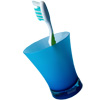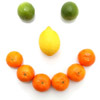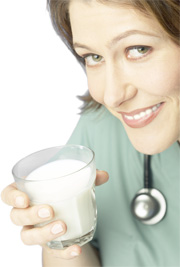- Introduction to nutrition and teeth
- Dietary sugars and teeth
Dietary factors that protect teeth
- Dietary recommendations
Introduction to nutrition and teeth
The main cause of tooth loss is tooth decay (also known as dental caries) and one of the most significant factors in the start of tooth decay is what we eat. The diet we consume can also play a significant role in erosion of teeth as well as the development of defects in the tooth structure (e.g. enamel hypoplasia, fluorosis). Gum disease (also known as periodontitis) is another cause of tooth loss. However, what we eat does not tend to affect gum disease as much as tooth decay.
Diet and tooth decay
There is no doubt that what we eat is linked with tooth decay. The bacteria that sits on our teeth, known as dental plaque, uses sugars in our diet as a source of energy so that more bacteria can form.
The bacteria metabolise sugars, and this results in the formation of acid that starts the process of tooth decay by softening the enamel or dentine.
Three bacteria are primarily involved with tooth decay:
- Streptococcus mutans;
- Certain Lactobacillus spp.; and
- Streptococcus sobrinus.
As acid is introduced into the mouth and eventually onto the teeth (from bacteria that release acids or from acidic food and drink) the mouth encounters a drop in pH (meaning it becomes more acidic). The pH at which damage to teeth occurs is 5.5. The normal pH is around 6.8-7.5. If the pH in the mouth remains above 5.5 for sufficient time then complete repair of enamel may occur following this initial damage. If the pH is too low for too long, then damage to the tooth will be greater than the repair of the tooth and this will result in tooth decay.
The repair process is a result of good saliva. Saliva provides lubrication, washes away sugars, has antibacterial components and has buffering components to fight against acidic attack. Dry mouth is related with higher tooth decay.
Diet and dental erosion
Dental erosion is the progressive loss of enamel and dentine that is chemically lost from the tooth surface in any way apart from acid released by bacteria.
Low salivary flow rate and poor buffering capacity to fight acidic challenges occur in people with dry mouth and so dental erosion can be a significant issue.
Acids can be intrinsic (from inside) or extrinsic (from external sources). Intrinsic acids are from vomiting and regurgitation. The extrinsic acids are from the diet, e.g. citric acid, phosphoric acid, ascorbic acid, malic acid, tartaric acid and carbonic acids found in fruits and fruit juices, soft drinks (both carbonated and still), some herbal teas, dry wines and vinegar-containing foods.
Dental fluorosis
Excess fluoride ingestion during enamel formation can lead to dental fluorosis and this condition is observed particularly in countries that have high levels of fluoride in water supplies. It is also observed in people, who in their childhood years ingested a reasonably high amount of fluoride via fluoride supplements or ingestion of fluoride containing mouthwashes and toothpastes.
Dietary sugars and teeth

- Frequency of sugar consumption;
- Timing of sugar ingestion; and
- Consistency (stickiness) of the sugar.
The conclusions we can make are that:
- Only a small increase in tooth decay is noted if sugar is taken with meals;
- Sugar consumed as snacks between meals is associated with a marked increase in tooth decay;
- Tooth decay is greatest if consumed in the form of sticky sugar-containing candies;
- Tooth decay activity may vary greatly among individuals; and
- Tooth decay will decline with the withdrawal of sugar-rich foods.
Frequency and amount of sugars consumed
Products that are sticky, retained for long periods in the mouth or consumed with high frequency have a greater chance of causing tooth decay than foods that are eliminated quickly from the oral cavity. Therefore, frequent sucking or chewing of foods such as hard candies and throat lozenges that contain fermentable carbohydrates can be extremely harmful to the teeth.
It is interesting to note that there is only a small link between the total amount of sugar we eat and the chance of tooth decay. However, the frequency of intake of sugars is strongly associated with tooth decay, with people who have sugary snacks more often tending to have a higher decay rate.
Types of sugar
In general, we eat a mix of sugars and other carbohydrates including sucrose, glucose, lactose and highly processed starches that are able to be used as energy sources for bacteria to cause tooth decay.
Stickiness of food can also lead to tooth decay as it is in the mouth for longer periods. However, food and drinks that are sugary and not sticky can still lead to increased decay rates.
Fluoride, sugar and decay

Fluoride affects teeth in three ways:
- Fluoride is able to become a part of the tooth’s structure and form fluoroapatite, which is better at resisting the acid attack that may be experienced by the tooth;
- Fluoride can repair the initial stages of decay; and
- Fluoride also affects the amount of acid that can be released by the bacteria in dental plaque, thus reducing the chance of decay.
Fluoride is the most effective preventive agent against tooth decay. Widespread use of fluoride largely accounts for the decline in tooth decay over the last 30 years.
The conclusions regarding fluoride in our diet are as follows:
- Where there is good exposure to fluoride, sugars consumption is a moderate risk factor for caries in most people; and
- With widespread use of fluoride, sugars consumption still has a role to play in the prevention of caries but this role is not as strong as it is without exposure to fluoride.
Starch and teeth
Starch is essentially a type of carbohydrate that is often plant-derived. Starches are sometimes consumed raw (e.g. in fruits and vegetables) but are largely consumed in a cooked form.
The conclusions regarding starch appear to indicate that:
- Cooked staple starchy foods such as rice, potatoes and bread are of low decay risk to people;
- The risk of tooth decay from uncooked starch e.g. rice, maize, and potatoes is very low;
- Finely ground and heat-treated starch e.g. bread, pancakes, cereals, and noodles can cause tooth decay but the risk compared to sugar is much less;
- The addition of sugar to cooked starches increases the risk of tooth decay.
Dietary factors that protect teeth
Tooth decay
Plaque pH studies have shown that consuming cheese following a sugary snack virtually abolishes the usual fall in pH that is associated with sugars consumption.
Cows’ milk contains calcium, phosphorus and casein all of which are thought to inhibit tooth decay.
Sugar alcohols including sorbitol, mannitol and xylitol have a much lower calorie content compared with sugars such as sucrose and have been recognised as having a low caries-producing potential. They are often used in chewing gum.
In line with the overall positive health effects of breastfeeding, those children who have been breastfed have lower rates of tooth decay.
Black tea, which contains fluoride, appears to be beneficial for resisting tooth decay due to the large benefits of fluoride in our diet.
Dental erosion
An association exists between dental erosion and the consumption of a number of acidic foods and drinks including frequent consumption of:
- Vinegar;
- Pickles;
- Citrus fruits;
- Berries; and
- Fruit juice at bedtime.
Consuming acidic beverages and foods frequently is a more important determinant of erosion than total amount of acidic foods consumed. These foods will cause erosion even in individuals with good dental hygiene.
Risk factors for erosion include:
- Consumption of citrus fruits twice or more per day;
- Consumption of soft drinks or fruit juices once per day;
- Drinking cola continuously or holding cola in the mouth;
- Sucking lemon wedges;
- Addition of baby fruit juices to comforters or reservoir feeders;
- Mega doses of chewable vitamin C, and other medications;
- Consumption of vinegar or sports drinks more than once a week;
- Eating disorders (largely due to the effect of intrinsic acids on vomiting);
- Gastro-oesophageal reflux; and
- A low salivary flow rate.
Recommendations for people at risk of dental erosion:
- Reduce acid exposure by reducing the frequency, and contact time of acids;
- Avoid acidic foods and drinks last thing at night;
- Do not hold or swish acidic drinks;
- Avoid sipping acidic drinks and try and use a straw;
- Avoid toothbrushing immediately before or after an acid attack;
- Use a soft toothbrush and low abrasive toothpaste;
- Consider using chewing gum or lozenges to stimulate saliva flow following an acid attack, or to reduce postprandial (following a meal) reflux; and
- Seek medical care when intrinsic causes are involved such as gastro-oesophageal reflux disease.
Gum disease
Apart from severe vitamin C deficiency, which results in scurvy-related gum disease, there is little evidence for an association between diet and gum disease.
It seems likely that gum disease is more severe and progresses faster in undernourished populations than healthy people. Malnourished people often have poor resistance to infections and are more prone to them, thus explaining why they have a relatively quick rate of gum disease.
Dietary recommendations

Sugary items and carbohydrates (that can be used as sources of energy by bacteria) eaten alone, cause a drop in the pH, which favours tooth decay. However, if a non-sugary item that stimulates saliva is eaten immediately before, during, or after this challenge, then the pH will rise, and the saliva will help prevent tooth decay from progressing.
There is a potential for repair when calcium-rich and fluoride rich foods are included in a healthy diet (such as cow’s milk, cheese, tea, tap water). Inclusion of milk or non-fat yoghurt with a meal or snack will reduce the chance of tooth decay. In one study, elderly people who ate cheese had less decay on their teeth.
Eating fermentable carbohydrates e.g. crackers, cola, caramels, raisins and cookies, one after the other over a significant period of time will increase the amount of decay in the mouth, as the pH will remain lower for a longer time and thus favour the progression of tooth decay.
Eating chewy foods (e.g. peanuts) and more basic foods like tuna fish (a high-quality protein) are all recommended if eating a sugar-rich food, or high in refined carbohydrates as they can minimise the risk of tooth decay and dental erosion.
Finally, it is important to have a well-balanced diet. A diet high in carbohydrates is unhealthy for the body as well as for your teeth, and those who snack quite often on potato chips and other carbohydrate and fat-rich snacks tend to have a high occurrence of tooth decay. Diets that promote a variety of foods and moderation are going to contribute to both dental and general health.
Pregnancy
 |
There is emerging interest in the effect of the prenatal period on tooth development and the future risk of tooth decay for the child. Pregnancy, thus, is a critical time to focus on good dental hygiene.For more information, see Dental Health and Nutrition During Pregnancy. |
0–1 years of age
 |
Nutritional needs for the first year of infancy are met primarily by breast milk and/or infant formula, followed by sequential introduction of baby foods starting with fortified cereals at approximately 6 months of age.For more information, see Effect of Nutrition on Dental Health from Birth to One Year of Age. |
1–2 years of age
 |
Between the age of 12 and 24 months, most of the remaining primary teeth erupt, and by the third birthday, all of the 20 primary teeth have erupted. Feeding behavior changes throughout the toddler years.For more information, see Effect of Nutrition on Dental Health from One to Two Years of Age. |
2–5 years of age
 |
At these ages, caregivers and healthcare workers need to ensure that good dietary habits, including regular meal patterns, are instilled in the child.For more information, see Effect of Nutrition on Dental Health from Two to Five Years of Age. |
More information
 |
For more information on dental health in children, including teething, hygiene and nutrition for good teeth, as well as the importance of dental check-ups, see Dental Health in Children. |
 |
For more information on nutrition, including information on types and composition of food, nutrition and people, conditions related to nutrition, and diets and recipes, as well as some useful videos and tools, see Nutrition. |
References
- Moynihan P, Petersen PE. Diet, nutrition and the prevention of dental diseases. Public Health Nutr. 2004; 7(1A): 201-26.
- Tinanoff N, Palmer CA. Dietary determinants of dental caries and dietary recommendations for preschool children. J Public Health Dent. 2000; 60(3): 197-209.
- Arens U. Oral Health, Diet and Other Factors: Report of the British Nutrition Foundation Task Force. Amsterdam: Elsevier, 1998.
- Dowden J (ed). Therapeutic Guidelines: Oral and Dental (1st edition). North Melbourne: Therapeutic Guidelines Limited, 2007.
- Arends J, Bosch JJ. In vivo de- and remineralization of dental enamel. In: Leach SA. Factors relating to demineralization and remineralization of the teeth. Oxford: IRL Press, 1985; 1-11.
- Mobley CC. Nutrition and dental caries. Dent Clin North Am. 2003; 47(2): 319-36.
- Kaufman E, Lamster IB. The diagnostic applications of saliva – a review. Crit Rev Oral Biol Med. 2002; 13(2): 197-212.
- Petersson GH, Bratthall D. The caries decline: A review of reviews. Eur J Oral Sci. 1996; 104 (4 Pt 2): 436-43.
- Roberson TM, Heymann HO, Swift EJ Jr (eds). Sturdevant’s Art and Science of Operative Dentistry (4th edition). St Louis: McGraw-Hill, 2002.
- Zero D, Lussi A. Etiology of enamel erosion: Intrinsic and extrinsic factors. In: Addy M, Embery G, Edgar WM (eds). Tooth Wear and Sensitivity: Clinical Advances in Restorative Dentistry. London: Martin Dunitz Ltd, 2000; 121-40.
- Ellwood RP, Cury JA. How much toothpaste should a child under the age of 6 years use? Eur Arch Paediatr Dent. 2009; 10(3): 168-74.
- Gustafsson BE, Quensel CE, Lanke LS, Lundqvist C, Grahnen H, Bonow BE, et al. The Vipeholm dental caries study: The effect of different levels of carbohydrate intake on caries activity in 436 individuals observed for five years. Acta Odontol Scand. 1954; 11(3-4): 232-64.
- Burt BA, Eklund SA, Morgan KJ, Larkin FE, Guire KE, Brown LO, et al. The effects of sugars intake and frequency of ingestion on dental caries increment in a three-year longitudinal study. J Dent Res. 1988; 67(11): 1422-9.
- Jamel HA, Sheiham A, Watt RG, Cowell CR. Sweet preference, consumption of sweet tea and dental caries; Studies in urban and rural Iraqi populations. Int Dent J. 1997; 47(4): 213-7.
- Murray JJ. Appropriate Use of Fluorides for Human Health. Geneva: World Health Organization, 1986.
- Rugg-Gunn AJ. Nutrition and Dental Health. Oxford: Oxford Medical Publications, 1993.
- Rugg-Gunn AJ, Edgar WM, Geddes DA, Jenkins GN. The effect of different meal patterns upon plaque pH in human subjects. Br Dent J. 1975; 139(9): 351-6.
- Frostell G. A method for evaluation of acid potentialities of foods. Acta Odontol Scand. 1970; 28(5): 599-622.
- Silver DH. A longitudinal study of infant feeding practice, diet and caries, related to social class in children aged 3 and 8-10 years. Br Dent J. 1987; 163(9): 296-300.
- Linkosalo E, Markkanen H. Dental erosions in relation to lactovegetarian diet. Scand J Dent Res. 1985; 93(5): 436-41.
- Millward A, Shaw L, Smith A. Dental erosion in four-year-old children from differing socioeconomic backgrounds. ASDC J Dent Child. 1994; 61(4): 263-6.
- Millward A, Shaw L, Smith AJ, Rippin JW, Harrington E. The distribution and severity of tooth wear and the relationship between erosion and dietary constituents in a group of children. Int J Paediatr Dent. 1994; 4(3): 151-7.
- Fuller JL, Johnson WW. Citric acid consumption and the human dentition. J Am Dent Assoc. 1977; 95(1): 80-4.
- High AS. An unusual pattern of dental erosion. A case report. Br Dent J. 1977; 143(12): 403-4.
- Smith AJ, Shaw L. Baby fruit juices and tooth erosion. Br Dent J. 1987; 162(2): 65-7.
- Giunta JL. Dental erosion resulting from chewable vitamin C tablets. J Am Dent Assoc. 1983;107(2): 253-6.
- Lussi A, Hellwig E. Risk assessment and preventive measures. Monogr Oral Sci. 2006; 20: 190-9.
- Enwonwu CO. Interface of malnutrition and periodontal diseases. Am J Clin Nutr. 1995; 61(2): 430-6S.
- Mobley C. Dietary analysis in a restorative practice. In: Duke ES (ed). Proceedings of the 5th Annual Indiana Conference on the Changing Practice of Restorative Dentistry. Indianapolis: Indiana University School of Dentistry, 2002; 139-56.
- Geddes DA. Diet patterns and caries. Adv Dent Res. 1994; 8(2): 221-4.
- Papas AS, Joshi A, Palmer CA, Giunta JL, Dwyer JT. Relationship of diet to root caries. Am J Clin Nutr. 1995; 61(2): 423-9S.
- Gatenby SJ. Eating frequency: Methodological and dietary aspects. Br J Nutr. 1997;77 Suppl 1: S7-20.
All content and media on the HealthEngine Blog is created and published online for informational purposes only. It is not intended to be a substitute for professional medical advice and should not be relied on as health or personal advice. Always seek the guidance of your doctor or other qualified health professional with any questions you may have regarding your health or a medical condition. Never disregard the advice of a medical professional, or delay in seeking it because of something you have read on this Website. If you think you may have a medical emergency, call your doctor, go to the nearest hospital emergency department, or call the emergency services immediately.








